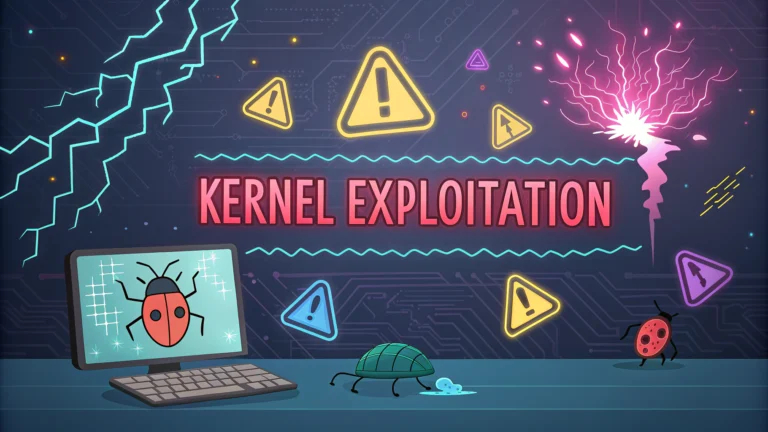Kernel exploitation represents one of the most sophisticated areas of cybersecurity, allowing attackers to manipulate operating system kernels for elevated privileges and system control.
Security researchers and penetration testers use kernel exploitation techniques to identify and report critical vulnerabilities before malicious actors can discover them.
This guide covers essential kernel exploitation methods, tools, and defensive measures for security professionals working in penetration testing and vulnerability research.
Understanding Kernel Architecture
The kernel operates as the core program managing all system resources and hardware interactions.
- Memory Management
- Process Scheduling
- Device Management
- System Calls
- Security Controls
Common Kernel Vulnerabilities
- Buffer Overflows
- Use-After-Free
- Race Conditions
- Integer Overflows
- Null Pointer Dereferences
Essential Tools for Kernel Exploitation
| Tool | Purpose |
|---|---|
| GDB | Kernel debugging and analysis |
| QEMU | System emulation for testing |
| Syzkaller | Kernel fuzzing |
Exploitation Techniques
Return-Oriented Programming (ROP) chains enable bypassing kernel security protections like KASLR.
Stack pivoting techniques allow attackers to control execution flow despite limited buffer space.
Heap spraying helps create predictable memory layouts for reliable exploitation.
Defense Mechanisms
- KASLR – Kernel Address Space Layout Randomization
- SMEP – Supervisor Mode Execution Prevention
- SMAP – Supervisor Mode Access Prevention
- kCFI – Kernel Control Flow Integrity
Practice Environments
Set up isolated testing environments using virtual machines or containers.
- Linux Kernel Development VM
- Vulnerable Kernel Modules
- CTF Challenges
Resources for Learning
- Linux Kernel Source: GitHub Repository
- Kernel Exploitation Books:
- “A Guide to Kernel Exploitation” by Enrico Perla
- “Linux Kernel Security and Development” by Bob Cromwell
- Online Communities:
- OWASP Kernel Project
- Linux Kernel Security Mailing List
Building Your Security Strategy
Document all findings and maintain detailed logs of exploitation attempts for proper vulnerability reporting.
Follow responsible disclosure practices when discovering kernel vulnerabilities.
Regularly update testing environments to match current kernel versions and security features.
Advanced Exploitation Scenarios
Modern kernel exploitation requires understanding complex attack chains and vulnerability combinations.
- Privilege Escalation Chains
- Container Escape Techniques
- Cross-Platform Exploitation
Automation and Tooling
Developing custom tools enhances kernel vulnerability research efficiency.
Key Components
- Automated Fuzzing Scripts
- Custom Exploit Templates
- Vulnerability Scanners
Documentation and Reporting
Maintaining detailed technical documentation ensures reproducibility and effective communication with vendors.
- Proof of Concept Code
- Impact Analysis
- Mitigation Recommendations
Risk Assessment Framework
| Risk Level | Impact Criteria |
|---|---|
| Critical | System compromise with root access |
| High | Privilege escalation potential |
| Medium | Information disclosure |
Future of Kernel Security
Emerging technologies and hardware-based security features reshape the kernel exploitation landscape.
- Hardware-assisted Security
- AI-based Detection Systems
- Zero-Trust Architecture Integration
Securing Tomorrow’s Systems
Success in kernel security requires continuous learning and adaptation to emerging threats.
Implement defense-in-depth strategies combining multiple security layers and controls.
Foster collaboration between security researchers and kernel developers to build more resilient systems.
FAQs
- What is kernel exploitation in penetration testing?
Kernel exploitation is the process of identifying and exploiting vulnerabilities in an operating system’s kernel to gain elevated privileges or complete system control. - What are common types of kernel vulnerabilities?
Common kernel vulnerabilities include buffer overflows, use-after-free conditions, race conditions, integer overflows, and privilege escalation flaws in kernel modules or drivers. - Which tools are essential for kernel exploitation?
Essential tools include GDB with kernel debugging extensions, QEMU for virtualization, Metasploit Framework, Linux Exploit Suggester, and kernel debugging tools like WinDbg for Windows systems. - What is a NULL pointer dereference in kernel exploitation?
A NULL pointer dereference occurs when the kernel attempts to access memory address 0x0, which can lead to denial of service or, in some cases, privilege escalation vulnerabilities. - How does Return Oriented Programming (ROP) apply to kernel exploitation?
ROP in kernel exploitation involves chaining existing code fragments (gadgets) from kernel memory to bypass security protections and execute arbitrary code with kernel privileges. - What is KASLR and how does it affect kernel exploitation?
Kernel Address Space Layout Randomization (KASLR) is a security feature that randomizes kernel memory locations to make exploitation more difficult by preventing predictable memory addresses. - What is SMEP/SMAP in kernel security?
Supervisor Mode Execution Prevention (SMEP) and Supervisor Mode Access Prevention (SMAP) are CPU security features that prevent the kernel from executing or accessing user-space memory, respectively. - How do kernel exploits bypass KPTI (Kernel Page Table Isolation)?
Kernel exploits bypass KPTI through techniques like finding information leaks, exploiting misconfigured kernel modules, or using gadgets that are still accessible in the kernel’s virtual memory space. - What role do Custom Kernel Modules play in exploitation?
Custom Kernel Modules can be used to introduce vulnerabilities, test exploit techniques, and understand kernel behavior during the exploitation process. - What are race conditions in kernel exploitation?
Race conditions occur when timing-sensitive operations in the kernel are exploited to cause unintended behavior, potentially leading to privilege escalation or memory corruption.







